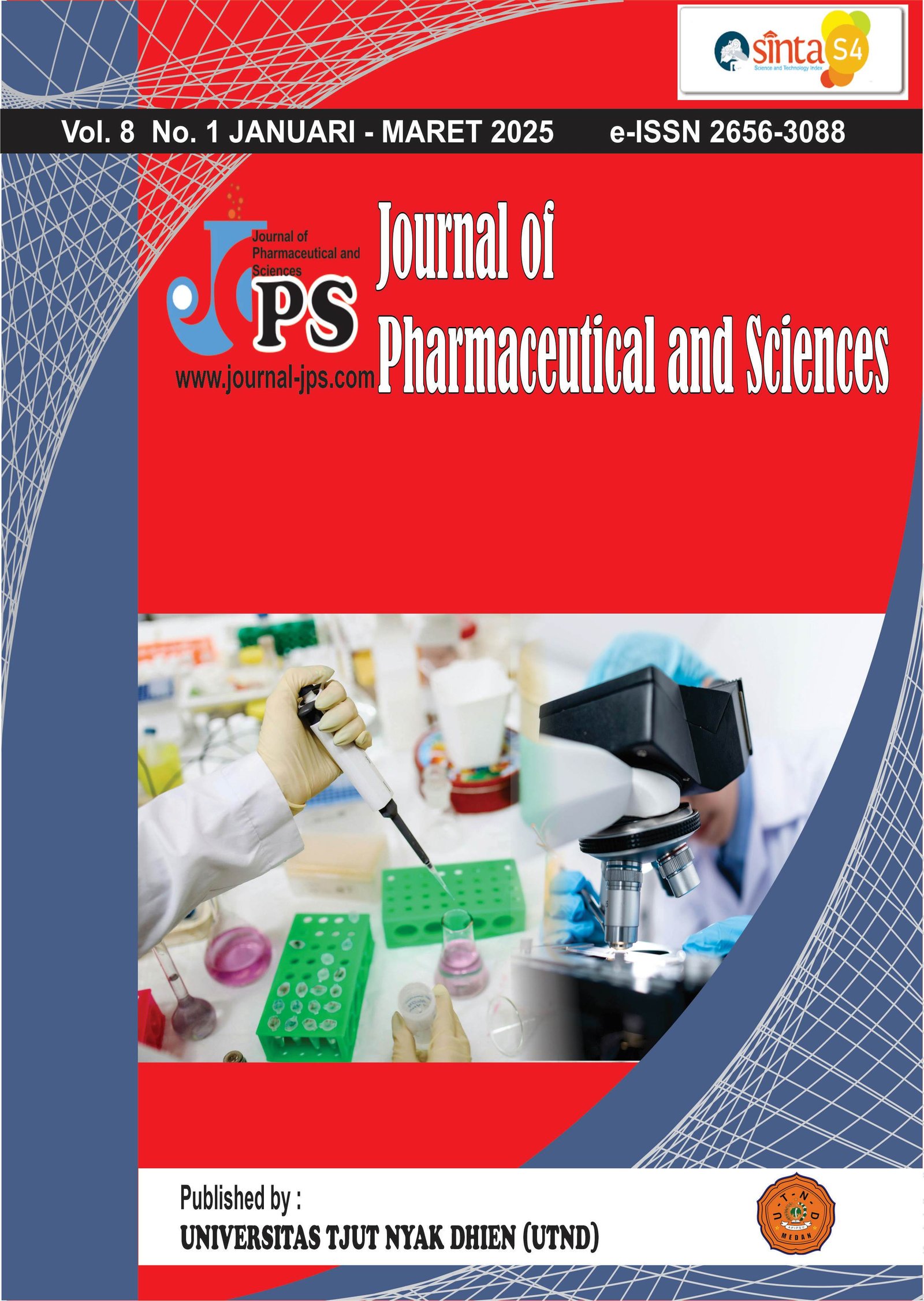Efektivitas krim ekstrak daun melinjo (Gnetum gnemon L.) terhadap jumlah sel fibroblas pada luka bakar derajat II dalam tikus putih (Rattus norvegicus)
Isi Artikel Utama
Page: 216-223
Abstrak
Luka bakar merupakan cedera yang menyebabkan kerusakan jaringan umumnya akibat kontak dengan sumber panas. Fibroblas mempunyai peran penting dalam penyembuhan luka yang mensintesis kolagen sebagai unsur utama matriks ekstraselular yang penting pada integritas luka. Tujuan penelitian ini adalah untuk mengetahui efektivitas krim ekstrak daun melinjo (EDM) (Gnetum gnemon L.) terhadap jumlah sel fibroblas luka bakar derajat II pada tikus putih (Rattus novegicus). Dua puluh ekor tikus putih (Rattus novegicus) jantan dibagi menjadi lima kelompok perlakuan dengan jumlah empat ulangan setiap kelompok diinduksi dengan luka bakar derajat II dalam. Kelompok kontrol negatif (K-) diterapi dengan basis krim, Kelompok kontrol positif (K+) diterapi dengan Silver Sulfadiazine, kelompok perlakuan P1, P2, dan P3 masing-masing diterapi dengan krim EDM dengan konsentrasi 2,5% , 5%, dan 10%. Terapi diberikan dua kali dalam sehari selama 14 hari. Oneway ANOVA menunjukkan adanya perbedaan nyata dari tiap kelompok perlakuan (p <0,05) dan dilanjutkan dengan uji Duncan. Rata-rata jumlah fibroblas setiap kelompok perlakuan menunjukkan bahwa kelompok K- berbeda nyata dengan kelompok K+, P2, P3 Namun tidak pada P1. Jumlah rata -rata sel fibroblas terendah ditemukan pada kelompok K+. Kesimpulan dari penelitian yang telah dilakukan adalah pemberian krim ekstrak daun melinjo (Gnetum gnemon L.) pada luka bakar derajat II dalam mampu menunjukan percepatan fase penyembuhan luka menuju fase selanjutnya ditandai dengan keberadaan jumlah sel fibroblas yang menurun
Unduhan
Rincian Artikel

Artikel ini berlisensiCreative Commons Attribution-NonCommercial-ShareAlike 4.0 International License.
Referensi
Noorbakhsh, S. I., Bonar, E. M., Polinski, R., & Amin, M. S. (2021). Educational Case: Burn Injury-Pathophysiology, Classification, and Treatment. Academic pathology, 8, 23742895211057239. https://doi.org/10.1177/23742895211057239
Wilkinson, H. N., & Hardman, M. J. (2020). Wound healing: cellular mechanisms and pathological outcomes. Open biology, 10(9), 200223. https://doi.org/10.1098/rsob.200223
Destri, C. (2017). Potensi Jatropha multifida Terhadap Jumlah Fibroblast pada Aphthous Ulcer Mukosa Mulut Tikus. Jurnal Biosains Pascasarjana, 19(1), 14–26. https://doi.org/10.20473/jbp.v19i1.2017.14-26
Sumbayak, E.M. 2016. Fibroblas: Struktur dan Peranannya dalam Penyembuhan Luka.
Shukla, S. K., Sharma, A. K., Gupta, V., & Yashavarddhan, M. H. (2019). Pharmacological control of inflammation in wound healing. Journal of tissue viability, 28(4), 218–222. https://doi.org/10.1016/j.jtv.2019.09.002
Lagziel, T., Asif, M., Born, L., Quiroga, L. H., Duraes, E., Slavin, B., Shetty, P., Caffrey, J., & Hultman, C. S. (2021). Evaluating the Efficacy, Safety, and Tolerance of Silver Sulfadiazine Dressings Once Daily Versus Twice Daily in the Treatment of Burn Wounds. Journal of burn care & research : official publication of the American Burn Association, 42(6), 1136–1139. https://doi.org/10.1093/jbcr/irab141
Walia, S. S., & Prasad, D. N. (2022). Silver Sulfadiazine: Action on Burn Wound Sepsis and Infections. Journal of Drug Delivery and Therapeutics, 12(4), 154–161. https://doi.org/10.22270/jddt.v12i4.5419
Mollejon CV and Gabane LS. 2019. Nutritional and nutraceutical content of Gnetum gnemon (bago) leaf extract. Int J Res. 39(2):1–13.
Al-Khayri, J. M., Sahana, G. R., Nagella, P., Joseph, B. V., Alessa, F. M., & Al-Mssallem, M. Q. (2022). Flavonoids as Potential Anti-Inflammatory Molecules: A Review. Molecules (Basel, Switzerland), 27(9), 2901. https://doi.org/10.3390/molecules27092901
Aslam, Muhammad & Riaz, Humayun & Raza, Syed Atif & Hussain, Shahzad & Qureshi, Omer & Hamzah, Zainab & Javed, Osama & Ahmad, Muhammad SyarhabiL. 2018. Role of Flavonoids as Wound Healing Agent. 10.5772/intechopen.79179.
Suzery, M., S. Lestari dan B. Cahyono. 2010. Penentuan Total Antosianin dari Kelopak Bunga Rosela (Hibiscus sabdariffa L) dengan Metode Maserasi dan Sokhletasi. Jurnal Sains & Matematika. 1(18).
Lazuardi, M. 2019. Bagian Khusus Ilmu Farmasi Veteriner. 1st Ed. Airlangga University Press (AUP). Surabaya. 84-154.
UCSF-IACUC. 2022. Guidelines - Preparation Of Ketamine Anesthesia Cocktail For Mice.
Abdeldjelil, M. C., A. Messai., A. Boudebza and S. BeghouL. 2017. Practical Aspects to Generate Cutaneous Experimental Burns in A Rat Model Scholars. Der Pharmacia Lettre. 9(1): 70-84.
Fuadi, M., Elfiah, U., & Misnawi, M. (2015). Jumlah Fibroblas pada Luka Bakar Derajat II pada Tikus dengan Pemberian Gel Ekstrak Etanol Biji Kakao dan Silver Sulfadiazine (The Total Fibroblast on the Second Degree Burns of Rats after Treatment using Ethanolic Extract of Cocoa Beans). Pustaka Kesehatan, 3(2), 244-248. Retrieved from https://jurnaL.unej.ac.id/index.php/JPK/article/view/2567
Riliani, M., Kusuma, I., Halim, A., Muhammad, A., Fitrianto, A., & Eka Narendra, I.B. 2020. The Role of Fibroblast Proliferation in Wound Healing by Different Plants: An Experimental Study. Proceedings of the 1st Jenderal Soedirman International Medical Conference in conjunction with the 5th Annual Scientific Meeting (Temilnas) Consortium of Biomedical Science Indonesia.
Saeidinia, A., Keihanian, F., Lashkari, A. P., Lahiji, H. G., Mobayyen, M., Heidarzade, A., & Golchai, J. (2017). Partial-thickness burn wounds healing by topical treatment: A randomized controlled comparison between silver sulfadiazine and centiderm. Medicine, 96(9), e6168. https://doi.org/10.1097/MD.0000000000006168
Ashkani-Esfahani, S., Imanieh, M. H., Khoshneviszadeh, M., Meshksar, A., Noorafshan, A., Geramizadeh, B., Ebrahimi, S., Handjani, F., & Tanideh, N. (2012). The healing effect of arnebia euchroma in second degree burn wounds in rat as an animal modeL. Iranian Red Crescent medical journal, 14(2), 70–74.
Liu, E., Gao, H., Zhao, Y., Pang, Y., Yao, Y., Yang, Z., Zhang, X., Wang, Y., Yang, S., Ma, X., Zeng, J., & Guo, J. (2022). The potential application of natural products in cutaneous wound healing: A review of preclinical evidence. Frontiers in pharmacology, 13, 900439. https://doi.org/10.3389/fphar.2022.900439
Bainbridge P. (2013). Wound healing and the role of fibroblasts. Journal of wound care, 22(8), 407–412. https://doi.org/10.12968/jowc.2013.22.8.407
Xie, Y., Yang, W., Tang, F., Chen, X., & Ren, L. (2015). Antibacterial activities of flavonoids: structure-activity relationship and mechanism. Current medicinal chemistry, 22(1), 132–149. https://doi.org/10.2174/0929867321666140916113443
Polaka, S., Katare, P., Pawar, B., Vasdev, N., Gupta, T., Rajpoot, K., Sengupta, P., & Tekade, R. K. (2022). Emerging ROS-Modulating Technologies for Augmentation of the Wound Healing Process. ACS omega, 7(35), 30657–30672. https://doi.org/10.1021/acsomega.2c02675
Ardiana, T., Rizkia Putri Kusuma, A., & Dian Firdausy, M. (2015). Efektivitas pemberian gel binahong (anredera cordifolia) 5% terhadap jumlah sel fibroblast pada soket pasca pencabutan gigi marmut (Cavia cobaya). odonto : Dental Journal, 2(1), 64. https://doi.org/10.30659/odj.2.1.64-70
Li, K., Diao, Y., Zhang, H. et aL. 2011. Tannin extracts from immature fruits of Terminalia chebula Fructus Retz. promote cutaneous wound healing in rats. BMC Complement Altern Med 11: 86. https://doi.org/10.1186/1472-6882-11-86





